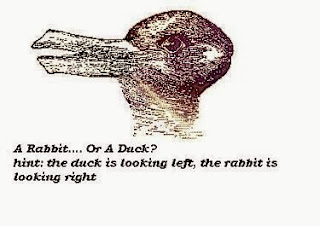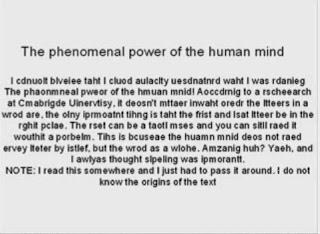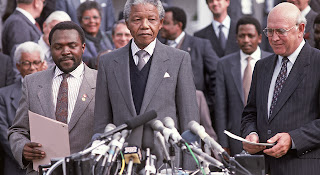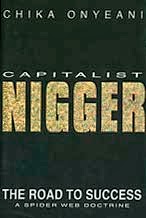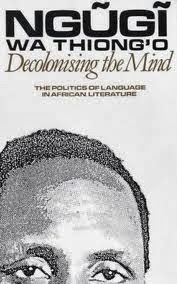It was the internal reforms of Mikhail Gorbachev, the last
Soviet leader, that contributed to the demise of the Soviet Union.
On March 11, 1985, Mikhail Gorbachev was elected General
Secretary of the Communist Party of the Soviet Union. At 54, he was the
youngest member of the ruling Politburo that voted him into power
Former National Security Adviser, General Brent Scowcroft,
said the Soviet Union previously had a succession of elderly leaders.
"So Gorbachev, I think, was brought in to stimulate the
system. And exactly how, we didn’t know. And I’m not sure he did,” said
Scowcroft.
For the next six years, Gorbachev embarked on a series of
domestic reforms that radically changed the Soviet Union.
Former U.S. Ambassador to Moscow Thomas Pickering said,
"What he attempted to do is, he analyzed where Russia was going and
attempted to ride a horse - instead, he was on the back of a bucking elephant.”
Gorbachev’s reforms touched all segments of society. It
included freeing press restrictions and releasing political prisoners and
dissidents from jail and internal exile.
Gorbachev's Domestic Reforms Led to End of Soviet Union
Gorbachev's Domestic Reforms Led to End of Soviet Union
“He was not a democrat, but he was trying to get more
efficiency out of the system and reduce the extent of coercion and oppression,”
said Scowcroft.
One institution Gorbachev failed to reform, however, was the
Soviet Communist Party. And it is within its ranks, along with the leadership
of the military and the KGB, that hardliners attempted a coup against Gorbachev
in August 1991.
But the coup failed.
“It was a pretty inept coup attempt. It was not carefully
planned, not carefully carried out,” said Scowcroft.
Pickering agrees, saying “It had bankrupt leadership. It was
in some ways vodka-soaked, elderly, old think."
The Soviet Union collapsed four months after the failed coup
attempt. And, said Scowcroft, that allowed Boris Yeltsin, Gorbachev’s nemesis,
to take Gorbachev head on.
Gorbachev's Domestic Reforms Led to End of Soviet Union
Gorbachev's Domestic Reforms Led to End of Soviet Union
“Now how do you eliminate Gorbachev? You pull the Soviet
Union right from under him. And I think the end of the Soviet Union, the
technical end of it, was in large part because then Gorbachev had no job,” said
Scowcroft.
Many experts say Gorbachev unleashed forces he ultimately
couldn’t contain - forces that inevitably led to the demise of the Soviet Union
on December 25, 1991, when Gorbachev resigned as Soviet president.
5:34 AM
On the night of November 9, 1989, the Berlin Wall--the most
potent symbol of the Cold War division of Europe--came down. Earlier that day,
the communist authorities of the German Democratic Republic had announced the
removal of travel restrictions to democratic West Berlin. Thousands of East
Germans streamed into the West, and in the course of the night, celebrants on
both sides of the wall began to tear it down.
The collapse of the Berlin Wall was the culminating point of
the revolutionary changes sweeping east central Europe in 1989. Throughout the
Soviet bloc, reformers assumed power and ended more than 40 years of
dictatorial communist rule. The reform movement that ended communism in east
central Europe began in Poland. Solidarity, an anti-communist trade union and
social movement, had forced Poland's communist government to recognize it in
1980 through a wave of strikes that gained international attention. In 1981,
Poland's communist authorities, under pressure from Moscow, declared martial
law, arrested Solidarity's leaders, and banned the democratic trade union. The
ban did not bring an end to Solidarity. The movement simply went underground,
and the rebellious Poles organized their own civil society, separate from the
communist government and its edicts.
In 1985, the assumption of power in the Soviet Union by a
reformer, Mikhail Gorbachev, paved the way for political and economic reforms
in east central Europe. Gorbachev abandoned the "Brezhnev
Doctrine"--the Soviet Union's policy of intervening with military force,
if necessary, to preserve communist rule in the region. Instead, he encouraged
the local communist leaders to seek new ways of gaining popular support for
their rule. In Hungary, the communist government initiated reforms in 1989 that
led to the sanctioning of a multiparty system and competitive elections. In
Poland, the communists entered into round-table talks with a reinvigorated
Solidarity. As a result, Poland held its first competitive elections since
before World War II, and in 1989, Solidarity formed the first noncommunist
government within the Soviet bloc since 1948. Inspired by their neighbors'
reforms, east Germans took to the streets in the summer and fall of 1989 to
call for reforms, including freedom to visit West Berlin and West Germany.
Moscow's refusal to use military force to buoy the regime of East German leader
Erich Honecker led to his replacement and the initiation of political reforms,
leading up to the fateful decision to open the border crossings on the night of
November 9, 1989.
In the wake of the collapse of the Berlin Wall, Czechs and
Slovaks took to the streets to demand political reforms in Czechoslovakia.
Leading the demonstrations in Prague was dissident playwright Vaclav Havel,
co-founder of the reform group Charter 77. The Communist Party of
Czechoslovakia quietly and peacefully transferred rule to Havel and the Czechoslovak
reformers in what was later dubbed the "Velvet Revolution." In
Romania, the communist regime of hardliner Nicolae Ceausescu was overthrown by
popular protest and force of arms in December 1989. Soon, the communist parties
of Bulgaria and Albania also ceded power.
The revolutions of 1989 marked the death knell of communism
in Europe. As a result, not only was Germany reunified in 1990, but soon,
revolution spread to the Soviet Union itself. After surviving a hard-line coup
attempt in 1991, Gorbachev was forced to cede power in Russia to Boris Yeltsin,
who oversaw the dissolution of the Soviet Union.
The collapse of communism in east central Europe and the
Soviet Union marked the end of the Cold War. The U.S. long-term policy of
containing Soviet expansion while encouraging democratic reform in central and
eastern Europe through scientific and cultural exchanges, information policy
(e.g., Radio Free Europe and Radio Liberty), and the U.S. own example, provided
invaluable support to the peoples of east central Europe in their struggle for
freedom.
5:32 AM
Road to
Democracy (1990-1994)
1990
On the 2nd February 1990 president of South Africa F.W. De
Klerk opened parliament with a speech that changed the course for South
Africa’s future. This was the start of
FW De Klerk dismantling the Apartheid regime which had previously ruled over
South Africa. Two of the key factors
that De Klerk had brought up were:
· Many
previously banned political parties such as the ANC and PAC to be unbanned.
· All
political prisoners to be released from prisons such as Robben Island
(Including Nelson Mandela).
· FW De
Klerk’s willingness to work with all political groups to create a new
democratic constitution for South Africa.
Reasons for FW De
Klerk’s Change
· The National
Party wanted to control the change and dismantle Apartheid so that they could
keep some power in doing so.
· The National
Party believed that the ANC would be politically weak after being banned for
the past 30 years.
· Sanctions
and disinvestments in South Africa had a great negative effect on South
Africa’s economy.
· The
resistance protests against Apartheid in the 1980’s showed that the Apartheid
government could only hold of these protests indefinitely.
Sebokeng Massacre
Negotiations for reform soon begin between the ANC and the
NP however these negotiations would be put on a halt due to on-going violence
in South Africa such as the Sebokeng Massacre.
The ANC realised that a 3rd force were instigating and causing
violence. IFP hostel dwellers were
intent on attacking ANC members in Sebokeng so therefore the ANC notified the
minister of law and order for security forces to protect them. However under police escort IFP members went
on to murder 30 ANC supporters.
3rd Force- An unknown
group of right wing extremists who provoked attacks on the ANC in order to
disrupt the negotiations to conserve South Africa and avoid reform.
Groote Schuur
Minute
After the violence period had ended the negotiations had
continued. Government officials (NP) and
ANC officials met at Groote Schuur in Cape Town in order to discuss and
negotiate the way forward. The highlight
of this negotiation was the end of dominant white rule by means of:
· Releasing all remaining political
prisoners.
· Granting
immunity to prosecuted political offenders.
· To bring
back political offenders in exile.
Pretoria Minute
Due to the success of the Groote Schuur Minute the
negotiations continued with the Pretoria Minute which was the next negotiation
conference held once again between NP and ANC officials except this time in
Pretoria. The main point of discussion
was the ANC’s announcement to suspend all armed action struggles (For the MK to
stop with all attacks).
MK (Umkhonto we Sizwe)- The ANC’s armed wing or army which
had been used during Apartheid as a form of violent protest by actions such as
setting off bombs in public areas. After the Pretoria Minute the NP government
ended the State of Emergency in South Africa except in Natal due to the
on-going violence.
1991 CODESA 1
 After the success of the negotiations between the ANC and NP
it was agreed that all factors rom all political parties should now be included
in the negotiation process, thus CODESA 1 was held at the World Trade Centre in
Kempton Park, Johannesburg.
After the success of the negotiations between the ANC and NP
it was agreed that all factors rom all political parties should now be included
in the negotiation process, thus CODESA 1 was held at the World Trade Centre in
Kempton Park, Johannesburg.
· 19 political
organisations (Excluding Pac and IFP) took part in CODESA 1.
· The
negotiations at CODESA were to discuss the formation of a multi-racial
government for the New South Africa.
· The
Declaration Of Intent was drawn up and signed by all political organisations
present which was a commitment by all
members to a goal towards an equal and undivided South Africa.
· The last of
the remaining Apartheid laws were dropped.
1992 White
Referendum
In early 1992 FW De Klerk ordered that a “whites only”
referendum be held on the issue of reform and to see what the response by the
white public was to reform. The
referendum came back with very positive results as 68% of white South Africans
voted towards a political reform.
CODESA 2
Due to the success of CODESA 1, a follow up known as CODESA
2 was held which was once again at the World Trade Centre in Kempton Park. Although CODESA 1 was a huge success, CODESA
2 was a was not very successful as all the political organisations failed to
meet a consensus over a majority rule or power sharing form of rule for the new
government. Political parties such as
the ANC wanted majority rule whereas the NP wanted power sharing. This discussion was also not helped by all
the on-going violence in the townships such as the Boipatong Massacre and Bisho
Stadium tragedy.
Majority Rule- A form of governance whereby the political
party with the majority of the vote (Who wins the election) has all power and
control over the governance of the country.
Power Sharing-A system of governance where dominant groups
share power with minorities and allow them some autonomy (Power in the
governance of the country).
Boipatong Massacre
On the 17th June 1992, township residents living in
Boipatong were attacked by armed IFP supporters whereby roughly 40 people were
killed and many more were injured.
Bisho Stadium
Tragedy
 On the 7th September 1992 around 80000 ANC supporters lead
by iconic ANC leaders such as Chris Hani gathered in Bisho in protest against
the leader of the homeland, OupaGqozo.
However when marchers tried to break through the lines of the Ciskei
Defense force’s lines, they opened fire on the marchers killing 28 and injuring
many more.
On the 7th September 1992 around 80000 ANC supporters lead
by iconic ANC leaders such as Chris Hani gathered in Bisho in protest against
the leader of the homeland, OupaGqozo.
However when marchers tried to break through the lines of the Ciskei
Defense force’s lines, they opened fire on the marchers killing 28 and injuring
many more.
Record of
Understanding
The Record of Understanding was an agreement between Roelf
Meyer of the NP and Cyril Ramaphosa of the ANC that the negotiation process had
to continue despite all the violence taking place and the ‘third force
elements’ in the country.
NP government members and ANC officials finally agreed on a
5 year term for government and political parties that gain over 5% in the
election would be proportionally represented.
1993 Chris Hani
Assassination
On the 10th April 1993 Chris Hani had just returned from the
corner café when he was gunned down by Janus Waluz on his driveway. This incident jolted the entire right wing
back into activity and placed them at the top of the political agenda. Later both Janus Waluz and Clive Derby-Lewis
were convicted of the crime and were sentenced.
This assassination formed a large amount of conflict in South Africa as
Hani was a very popular ANC leader, however Nelson Mandela addressed the nation
in order to avoid a civil war and keep the peace so that the negotiation
process could continue.
AWB Attack World
Trade Centre
On the 25 June 1993 members of the right wing AWB political
party demonstrated outside the World Trade Centre in Kempton Park during a
negotiation and later drove vehicles through the doors into the building. This was all part of the AWB to disrupt the
negotiation process as right wing conservatives.
1994
On the 27th April 1994 South Africa eventually reached its
first democratic election whereby all citizens of the country could vote. Over 19 million South Africa voted and later
it was concluded that the ANC had won the election and Nelson Mandela would be
the first democratic president of South Africa.
5:26 AM
As a resistance movement, the ANC was predated by a number
of black lumpenproletariat resistance movements, among them Umkosi Wezintaba,
formed in South Africa between 1890 and 1920.[1]
The ANC was formed on 8 January 1912 by John Dube, Pixley ka
Isaka Seme and Sol Plaatje along with chiefs, people's representatives, and
church organizations, and other prominent individuals to bring all Africans
together as one people to defend their rights and freedoms, the ANC from its
inception represented both traditional and modern elements, from tribal chiefs
to church and community bodies and educated black professionals, though women
were only admitted as affiliate members from 1931 and as full members in 1943.
The formation of the ANC Youth League in 1944 by Anton
Lembede heralded a new generation committed to building non-violent mass action
against the legal underpinnings of the white minority's supremacy.
In 1946 the ANC allied with the South African Communist
Party in assisting in the formation of the South African Mine Workers' Union.
After the miners strike became a general strike, the ANC's President General
Alfred Bitini Xuma along with delegates of the South African Indian Congress at
the 1946 session of the United Nations General Assembly where the treatment of
Indians in South Africa was raised by the Government of India. Together, they
raised the issue of the police brutality against the miners strike and the
wider struggle for equality in South Africa.[2] The ANC also worked with the
Natal Indian Congress and Transvaal Indian Congress.
Opposition to
Apartheid
The return of an Afrikaner-led National Party government by
the overwhelmingly white electorate in 1948 signaled the advent of the policy
of Apartheid. During the 1950s, non-whites were removed from electoral rolls, residence
and mobility laws were tightened and political activities restricted.
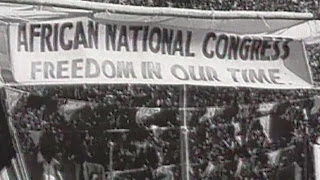 The successful increase of awareness outside of South Africa
achieved in the Indians' movement under the leadership of Gandhi inspired
blacks in South Africa to resist the racism and inequality that they, and all
other non-whites, were experiencing. The two racial groups began working
together, forcing themselves to accept one another and bash their own personal
prejudices against one another. This required effort: education supporting the
other race and their achievements, and constantly reminding themselves that
they needed one another to combat the oppression they were facing. They began
collaborating, even jointly campaigning for their struggle to be managed by the
United Nations (although in this time, western society was not practising
equality for all people either).[3]
The successful increase of awareness outside of South Africa
achieved in the Indians' movement under the leadership of Gandhi inspired
blacks in South Africa to resist the racism and inequality that they, and all
other non-whites, were experiencing. The two racial groups began working
together, forcing themselves to accept one another and bash their own personal
prejudices against one another. This required effort: education supporting the
other race and their achievements, and constantly reminding themselves that
they needed one another to combat the oppression they were facing. They began
collaborating, even jointly campaigning for their struggle to be managed by the
United Nations (although in this time, western society was not practising
equality for all people either).[3]
The ANC also found its role model in the initial movement by
the Indian political parties. They realized that they would need a fervent
leader, like Gandhi was for the Indians, who was, in the words of Nelson
Mandela, "willing to violate the law and if necessary go to prison for
their beliefs as Gandhi had". In 1949 the ANC saw a jump in their
membership, which previously lingered around five-thousand, and began to
establish a firm presence in South African society.[3]
In June 1952, the ANC joined with other anti-Apartheid
organizations in a Defiance Campaign against the restriction of political,
labour and residential rights, during which protesters deliberately violated
oppressive laws, following the example of Mahatma Gandhi's passive resistance
in KwaZulu-Natal and in India. The campaign was called off in April 1953 after
new laws prohibiting protest meetings were passed.
In June 1955 the Congress of the People, organised by the
ANC and Indian, Coloured and White organizations at Kliptown near Johannesburg,
adopted the Freedom Charter, henceforth the fundamental document of the
anti-Apartheid struggle with its demand for equal rights for all regardless of race.
As opposition to the regime's policies continued, 156 leading members of the
ANC and allied organisations were arrested in 1956; the resulting "Treason
Trial" ended with their acquittal five years later.
The ANC first called for an academic boycott of South Africa
in protest of its Apartheid policies in 1958 in Ghana. The call was repeated
the following year in London.[4]
In 1959 a number of members broke away from the ANC because
they objected to the ANC's reorientation from African nationalist policies.
They formed the rival Pan Africanist Congress (PAC), led by Robert Sobukwe.
Protest and
banning
The ANC planned a campaign against the Pass Laws, which
required blacks to carry an identity card at all times to justify their
presence in White areas, to begin on 31 March 1960. The PAC pre-empted the ANC
by holding unarmed protests 10 days earlier, during which 69 protesters were
killed and 180 injured by police fire in what became known as the Sharpeville
massacre.
In the aftermath of the tragedy, both organisations were
banned from political activity. International opposition to the regime
increased throughout the 1950s and 1960s, fueled by the growing number of newly
independent nations, the Anti-Apartheid Movement in Britain and the civil
rights movement in the United States. In 1960, the leader of the ANC, Albert
Luthuli, won the Nobel Peace Prize, a feat that would be repeated in 1993 by
the next leader of the ANC, Nelson Mandela, and F.W. de Klerk jointly, for
their actions in helping to negotiate peaceful transition after Mandela's
release from prison, which was a great step towards better rights for blacks.
Violent political
resistance
Following the Sharpeville massacre in 1960, the ANC
leadership concluded that the methods of non-violence such as those utilised by
Gandhi against the British Empire during their colonisation of India were not
 suitable against the Apartheid system. A military wing was formed in 1961,
called Umkhonto we Sizwe (MK), meaning "Spear of the Nation", with
Mandela as its first leader. MK operations during the 1960s primarily involved
targeting and sabotaging government facilities. Mandela was arrested in 1962,
convicted of sabotage in 1964 and sentenced to life imprisonment on Robben
Island, along with Sisulu and other ANC leaders after the Rivonia Trial.
suitable against the Apartheid system. A military wing was formed in 1961,
called Umkhonto we Sizwe (MK), meaning "Spear of the Nation", with
Mandela as its first leader. MK operations during the 1960s primarily involved
targeting and sabotaging government facilities. Mandela was arrested in 1962,
convicted of sabotage in 1964 and sentenced to life imprisonment on Robben
Island, along with Sisulu and other ANC leaders after the Rivonia Trial.
During the 1970s and 1980s the ANC leadership in exile under
Oliver Tambo made the decision to target Apartheid government leadership,
command and control, secret police, and military-industrial complex assets and personnel
in decapitation strikes, targeted killings, and guerilla actions such as bomb
explosions in facilities frequented by military and government personnel. A
number of civilians were also killed in these attacks. Examples of these
include the Amanzimtoti bombing,[5] the Sterland bomb in Pretoria,[6] the Wimpy
bomb in Pretoria,[7] the Juicy Lucy bomb in Pretoria[6] and the Magoo's bar
bombing in Durban.[8] ANC acts of sabotage aimed at government institutions
included the bombing of the Johannesburg Magistrates Court, the attack on the
Koeberg nuclear power station, the rocket attack on Voortrekkerhoogte in
Pretoria, and the 1983 Church Street bombing in Pretoria, which killed 16 and
wounded 130.
The ANC was classified as a terrorist [9] organisation by
the South African government and by some Western countries including the United
States of America and the United Kingdom. Nevertheless, the ANC had a London
office from 1978 to 1994 at 28 Penton Street in Islington, north London, now
marked with a plaque. [10]
During this period, the South African military engaged in a
number of raids and bombings on ANC bases in Botswana, Mozambique, Lesotho and
Swaziland. Dulcie September, a member of the ANC who was investigating the arms
trade between France and South Africa was assassinated in Paris in 1988. In the
ANC's training camps, the ANC faced allegations that dissident members faced
torture, detention without trial and even execution in ANC prison
camps.[11][12] In South Africa, the campaign to make the townships
"ungovernable" led to kangaroo courts and mob executions of opponents
and collaborators, often by necklacing.[13][14]
There was violence between the ANC and the Inkatha Freedom
Party. For example between 1985 and 1989, 5,000 civilians were killed in fighting
between the two parties.[15] Massacres of each other's supporters include the
Shell House massacre and the Boipatong massacre.
As the years progressed, the African National Congreses
attacks, coupled with international pressure and internal dissent, increased in
South Africa. The ANC received financial and tactical support from the USSR,
which orchestrated military involvement with surrogate Cuban forces through
Angola. However, the fall of the USSR after 1991 brought an end to its funding
of the ANC and also changed the attitude of some Western governments that had
previously supported the Apartheid regime as an ally against communism. The
South African government found itself under increasing internal and external
pressure, and this, together with a more conciliatory tone from the ANC,
resulted in a change in the political landscape. State President F.W. de Klerk
unbanned the ANC and other banned organisations on 2 February 1990, and began
peace talks for a negotiated settlement to end Apartheid.
multiracial elections--but do so in a landslide. In that
election, the ANC, as the dominant partner in a tripartite alliance with the
South African Communist Party and the Congress of South African Trade Unions,
won a comprehensive victory, and Nelson Mandela was elected the first black
President of South Africa.
In Kwa-Zulu Natal, the ANC maintained an uneasy coalition
with the Inkatha Freedom Party after neither party won a majority in the 1994
and 1999 provincial elections.
In 2004 the party contested national elections in voluntary
coalition with the New National Party (NNP), which it effectively absorbed
following the NNP's dissolution in 2005.
After the 1994 and 1999 elections it ruled seven of the nine
provinces, with Kwa-Zulu Natal under the IFP and the Western Cape Province
under the NNP. As of 2004, it gained both the Western Cape and Kwa-Zulu Natal
after a combination of the NNP's electoral base being eroded by the DA and a
poor showing by the IFP.
Signs of strain
By 2001 the tripartite alliance between the ANC, COSATU and
SACP began showing signs of strain as the ANC moved to more liberal economic
policies than its alliance partners were comfortable with. The focus for
dissent was the GEAR program, an initialism for "Growth, Employment and Redistribution."
In late 2004 this was again thrown into sharp relief by
Zwelinzima Vavi of COSATU protesting the ANC's policy of "quiet
diplomacy" towards the worsening conditions in Zimbabwe, as well as Black
Economic Empowerment, which he complained benefits a favoured few in the black
elite and not the masses.
As of 2005 the alliance was facing a crisis as Jacob Zuma,
who was fired from his position as Deputy President of South Africa by Thabo
Mbeki, faced corruption charges. Complicating the situation was the fact that
Zuma remained Deputy President of the ANC, and maintained a strong following
amongst many ANC supporters, and the ANC's alliance partners.[16] In October
2005, top officials in the National Intelligence Agency, who were Zuma
supporters, were suspended for illegally spying on an Mbeki supporter, Saki
Macozoma, amid allegations that ANC supporters were using their positions
within organs of state to spy on, and discredit each other.[17] In December
2005, Zuma was charged with rape [18] and his position as Deputy President of
the ANC was suspended.[19]
Jacob Zuma was acquitted of the rape charges, and was
reinstated as Deputy President of the organisation. A battle for leadership of
the ANC followed, culminating at the party's national conference in Polokwane
(16–20 December 2007), where both Jacob Zuma and Thabo Mbeki were nominated for
the position of president. On 18 December 2007, Jacob Zuma was elected
President of the ANC at the ANC conference in Polokwane[20]
The ANC also faced (sometimes violent) protests in townships
over perceived poor service delivery, as well as internal disputes, as local
government elections approached in 2006.[21][22]
The ANC "WaBenzi" are now commonly considered to
be more concerned with the spoils of power (such as BMWs, Whisky & Italian
Clothes) than they are with furthering the development of the people.
Leaders of the ANC[edit]
Presidents of the
ANC
1912 - 1917 John Langalibalele Dube (1871–1946)
1917 - 1924 Sefako Mapogo Makgatho (1861–1951)
1924 - 1927 Zacharias Richard Mahabane (1881–1970)
1927 - 1930 Josiah Tshangana Gumede (1870–1947)
1930 - 1936 Pixley ka Isaka Seme (1882–1951)
1937 - 1940 Zacharias Richard Mahabane (1881-1971)
1940 - 1949 Alfred Bitini Xuma (1890–1962)
1949 - 1952 James Sebe Moroka (1891-1985)
1952 - 1967 Albert John Lutuli (1898–1967)
1967 - 1991 Oliver Reginald Tambo (1917–1993)
1991 - 1997 Nelson Rolihlahla Mandela (1918-2013)
1997 - 2007 Thabo Mvuyelwa Mbeki (1942-)
2007–present Jacob Gedleyihlekisa Zuma (1942-)
Deputy Presidents
of the ANC
1952 - 1958 Nelson Mandela
1958 - 1985 Oliver Tambo
1985 - 1991 Nelson Mandela
1991 - 1994 Walter Sisulu
1994 - 1997 Thabo Mbeki
1997 - 2007 Jacob Zuma
2007 – 2012 Kgalema Motlanthe
2012 - incumbent Cyril Ramaphosa
Secretaries-General
of the ANC
(1912–1915) Sol Plaatje
(1915–1917) R. V. Selope Thema
(1917–1919) Saul Msane
(1919–1923) H. L. Bud M'belle
(1923–1927) T. D. Mweli Skota
(1927–1930) E. J. Khaile
(1930–1936) Elijah Mdolomba
(1936–1949) James Arthur Calata
(1949–1955) Walter Sisulu
(1955–1958) Oliver Tambo
(1958–1969) Duma Nokwe
(1969–1991) Alfred Nzo
(1991–1997) Cyril Ramaphosa
(1997–2007) Kgalema Motlanthe
(2007–present) Gwede Mantashe
4:51 AM
3:35 AM
During the Cuban Missile Crisis, leaders of the U.S. and the
Soviet Union engaged in a tense, 13-day political and military standoff in
October 1962 over the installation of nuclear-armed Soviet missiles on Cuba,
just 90 miles from U.S. shores. In a TV address on October 22, 1962, President
John Kennedy (1917-63) notified Americans about the presence of the missiles,
explained his decision to enact a naval blockade around Cuba and made it clear
the U.S. was prepared to use military force if necessary to neutralize this
perceived threat to national security. Following this news, many people feared
the world was on the brink of nuclear war. However, disaster was avoided when
the U.S. agreed to Soviet leader Nikita Khrushchev's (1894-1971) offer to
remove the Cuban missiles in exchange for the U.S. promising not to invade
Cuba. Kennedy also secretly agreed to remove U.S. missiles from Turkey.
Discovering the Missiles
 After seizing power in the Caribbean island nation of Cuba
in 1959, leftist revolutionary leader Fidel Castro (1926-) aligned himself with
the Soviet Union. Under Castro, Cuba grew dependent on the Soviets for military
and economic aid. During this time, the U.S. and the Soviets (and their
respective allies) were engaged in the Cold War (1945-91), an ongoing series of
largely political and economic clashes.
After seizing power in the Caribbean island nation of Cuba
in 1959, leftist revolutionary leader Fidel Castro (1926-) aligned himself with
the Soviet Union. Under Castro, Cuba grew dependent on the Soviets for military
and economic aid. During this time, the U.S. and the Soviets (and their
respective allies) were engaged in the Cold War (1945-91), an ongoing series of
largely political and economic clashes.
The two superpowers plunged into one of their biggest Cold
War confrontations after the pilot of an American U-2 spy plane making a
high-altitude pass over Cuba on October 14, 1962, photographed a Soviet SS-4
medium-range ballistic missile being assembled for installation.
President Kennedy was briefed about the situation on October
16, and he immediately called together a group of advisors and officials known
as the executive committee, or ExCom. For nearly the next two weeks, the
president and his team wrestled with a diplomatic crisis of epic proportions,
as did their counterparts in the Soviet Union.
A New Threat to the U.S.
For the American officials, the urgency of the situation
stemmed from the fact that the nuclear-armed Cuban missiles were being
installed so close to the U.S. mainland--just 90 miles south of Florida. From
that launch point, they were capable of quickly reaching targets in the eastern
U.S. If allowed to become operational, the missiles would fundamentally alter
the complexion of the nuclear rivalry between the U.S. and the Union of Soviet
Socialist Republics (USSR), which up to that point had been dominated by the
Americans.
Soviet leader Nikita Khrushchev had gambled on sending the
missiles to Cuba with the specific goal of increasing his nation's nuclear
strike capability. The Soviets had long felt uneasy about the number of nuclear
weapons that were targeted at them from sites in Western Europe and Turkey, and
they saw the deployment of missiles in Cuba as a way to level the playing
field. Another key factor in the Soviet missile scheme was the hostile
relationship between the U.S. and Cuba. The Kennedy administration had already
launched one attack on the island--the failed Bay of Pigs invasion in 1961--and
Castro and Khrushchev saw the missiles as a means of deterring further U.S.
aggression.
From the outset of the crisis, Kennedy and ExCom determined
that the presence of Soviet missiles in Cuba was unacceptable. The challenge
facing them was to orchestrate their removal without initiating a wider
conflict--and possibly a nuclear war. In deliberations that stretched on for
nearly a week, they came up with a variety of options, including a bombing
attack on the missile sites and a full-scale invasion of Cuba. But Kennedy
ultimately decided on a more measured approach. First, he would employ the U.S.
Navy to establish a blockade, or quarantine, of the island to prevent the
Soviets from delivering additional missiles and military equipment. Second, he
would deliver an ultimatum that the existing missiles be removed.
In a television broadcast on October 22, 1962, the president
notified Americans about the presence of the missiles, explained his decision
to enact the blockade and made it clear that the U.S. was prepared to use
military force if necessary to neutralize this perceived threat to national
security. Following this public declaration, people around the globe nervously
waited for the Soviet response. Some Americans, fearing their country was on
the brink of nuclear war, hoarded food and gas.
Showdown at Sea
A crucial moment in the unfolding crisis arrived on October
24, when Soviet ships bound for Cuba neared the line of U.S. vessels enforcing
the blockade. An attempt by the Soviets to breach the blockade would likely
have sparked a military confrontation that could have quickly escalated to a
nuclear exchange. But the Soviet ships stopped short of the blockade.
Although the events at sea offered a positive sign that war
could be averted, they did nothing to address the problem of the missiles
already in Cuba. The tense standoff between the superpowers continued through
the week, and on October 27, an American reconnaissance plane was shot down
over Cuba, and a U.S. invasion force was readied in Florida. (The 35-year-old
pilot of the downed plane, Major Rudolf Anderson, is considered the sole U.S.
combat casualty of the Cuban missile crisis.) "I thought it was the last
Saturday I would ever see," recalled U.S. Secretary of Defense Robert
McNamara (1916-2009), as quoted by Martin Walker in "The Cold War." A
similar sense of doom was felt by other key players on both sides.
A Deal Ends the
Standoff
Despite the enormous tension, Soviet and American leaders
found a way out of the impasse. During the crisis, the Americans and Soviets
had exchanged letters and other communications, and on October 26, Khrushchev
sent a message to Kennedy in which he offered to remove the Cuban missiles in
exchange for a promise by U.S. leaders not to invade Cuba. The following day,
the Soviet leader sent a letter proposing that the USSR would dismantle its
missiles in Cuba if the Americans removed their missile installations in
Turkey.
Officially, the Kennedy administration decided to accept the
terms of the first message and ignore the second Khrushchev letter entirely.
Privately, however, American officials also agreed to withdraw their nation's
missiles from Turkey. U.S. Attorney General Robert Kennedy (1925-68) personally
delivered the message to the Soviet ambassador in Washington, and on October
28, the crisis drew to a close.
Both the Americans and Soviets were sobered by the Cuban
Missile Crisis. The following year, a direct "hot line" communication
link was installed between Washington and Moscow to help defuse similar
situations, and the superpowers signed two treaties related to nuclear weapons.
The Cold War was far from over, though. In fact, another legacy of the crisis
was that it convinced the Soviets to increase their investment in an arsenal of
intercontinental ballistic missiles capable of reaching the U.S. from Soviet
territory.
3:30 AM
Capitalist Nigger is an explosive and
jarring indictment of the black race. The book asserts that the Negroid race, as
naturally endowed as any other, is culpably a non-productive race, a consumer
race that depends on other communities for its culture, its language, its
feeding and its clothing. Despite enormous natural resources, blacks are
economic slaves because they lack the ‘devil-may-care’ attitude and the ‘killer
instinct’ of the Caucasian, as well as the spider web mentality of the Asian. A
Capitalist Nigger must embody ruthlessness in pursuit of excellence in his
drive towards achieving the goal of becoming an economic warrior. In putting
forward the idea of the Capitalist Nigger, Chika Onyeani charts a road to
success whereby black economic warriors employ the ‘Spider Web Doctrine’ –
discipline, self-reliance, ruthlessness – to escape from their victim mentality.
Born in Nigeria, Chika Onyeani is a journalist, editor and former diplomat.
3:20 AM
Tweet
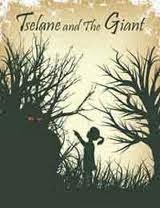 TSELANE AND THE GIANT
TSELANE AND THE GIANT
AFRICAN FOLKLORE
The story of Tselane and the Giant is about a little girl who lived with her mother in a village near the forest. Tselane’s mother worked in the fields and would come back home during the day to give Tselane lunch. Although they were happy, they were soon to be confronted with a problem: deep in the dark forest lived an evil giant who liked killing and eating little girls. Tselane and her mother lived in fear and every time the mother left to work in the fields, Tselane would lock herself inside the house. She would only open the door when her mother sang her a song, which was their magic password.
However, it was not long before the evil Giant found out about Tselane and her mother’s magic password, tricked Tselane, and kidnapped her with the help of a clever rabbit . . .
2:41 AM
Tweet
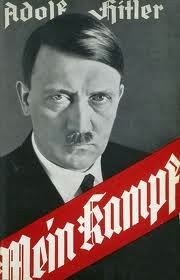 MEIN KAMPF(MY STRUGGLE)
MEIN KAMPF(MY STRUGGLE)
ADOLF HITLER
The book is Hitler's autobiographical work with emphasis on his philosophy regarding the state and politics. The book opens up how one of the most barbarian dictators in the history of mankind thought and justified his actions. It is known to everyone that Hitler molded the way history books as we see them today and committed one of the gravest crimes on the mankind, but what this book reveals is the underlying fuel that propelled this man. Its his beliefs and perspective towards the German nation that made him choose the specific political path. Hitler writes how the basic fundamentals of politics and society took shape in his mind starting from his very childhood and through his youth. His distaste towards parliamentary democracy is openly shown and he proves how such a system has brought upon the degradation of the political body of the nation and is incapable of doing any good. He states that the basic issue with parliamentary democracy is accountability since it can not be ascertained to a single person..
Hitler is a steadfast nationalist and in this book of his, he charts the way forward for the great German State. In the competition to gain more land and resources he clearly states that a nation needs to go out and acquire external land. He also professes that man should not come in the way of natural selection of the strongest and maintains that artificial means to stop population growth lowers the strength of the nation since in a natural selection process only the strongest would have survived in the competition. He also debates how only Aryan race is capable of fueling the progress of mankind and that the Jews have been working endlessly in order to dominate the human race and in doing so they use corrupt means of manipulating the societal structure in various nations. He clearly states that if Germany wants to reach its destiny, Jews need to be eradicated from the nation.
In the latter part of the book, he shows how he joins the German Labour Party and spearheads the youth movement to awaken the German nation. The party becomes increasingly popular under dynamic leadership of Hitler and his flare for public speaking come to fore in this struggle to gain political stature.
2:36 AM
Tweet
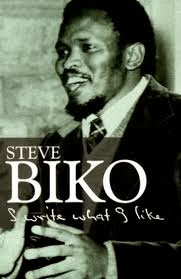 I WRITE WHAT I LIKE
I WRITE WHAT I LIKE
STEVE BIKO
"The most potent weapon in the hands of the oppressor is the mind of the oppressed." Like all of Steve Biko's writings, those words testify to the passion, courage, and keen insight that made him one of the most powerful figures in South Africa's struggle against apartheid. They also reflect his conviction that black people in South Africa could not be liberated until they united to break their chains of servitude, a key tenet of the Black Consciousness movement that he helped found.
I Write What I Like contains a selection of Biko's writings from 1969, when he became the president of the South African Students' Organization, to 1972, when he was prohibited from publishing. The collection also includes a preface by Archbishop Desmond Tutu; an introduction by Malusi and Thoko Mpumlwana, who were both involved with Biko in the Black Consciousness movement; a memoir of Biko by Father Aelred Stubbs, his longtime pastor and friend; and a new foreword by Professor Lewis Gordon.
Biko's writings will inspire and educate anyone concerned with issues of racism, postcolonialism, and black nationalism.
I Write What I Like contains a selection of Biko's writings from 1969, when he became the president of the South African Students' Organization, to 1972, when he was prohibited from publishing. The collection also includes a preface by Archbishop Desmond Tutu; an introduction by Malusi and Thoko Mpumlwana, who were both involved with Biko in the Black Consciousness movement; a memoir of Biko by Father Aelred Stubbs, his longtime pastor and friend; and a new foreword by Professor Lewis Gordon.
Biko's writings will inspire and educate anyone concerned with issues of racism, postcolonialism, and black nationalism.
2:30 AM
Tweet
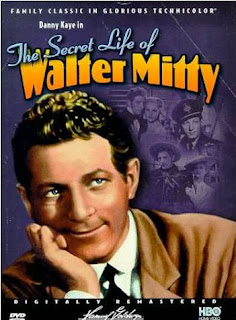 SECRET LIFE OF WALTER MITTY
SECRET LIFE OF WALTER MITTY
JAMES THURBER
"The Secret Life of Walter Mitty" tells the story of the aging Walter Mitty on a trip into town with his overbearing wife, Mrs. Mitty. Walter is inept at many things; he is an absent-minded driver, he can't handle simple mechanical tasks, and he forgets things easily. What makes Walter exceptional is his imagination.
While Walter goes through a day of ordinary tasks and errands, he escapes into a series of romantic fantasies, each spurred on by some mundane reality. As he drives his car, he imagines he is commanding "a Navy hydroplane" through a terrible storm (1). When he rides past a hospital, he imagines he is a world-famous surgeon saving a VIP's life. When he hears a newsboy shouting about a trial, he imagines he is a crack shot being interrogated in the courtroom. As he waits for his wife to finish at the hairdresser's, Walter sees pictures of German plane and imagines he is a British pilot willing to sacrifice his life for his country. Lastly, as Mitty waits outside against a wall for his wife to buy something in a drugstore, he fantasizes that he is a bold and brave man about to be shot by a firing squad. The story ends with the inscrutable Walter Mitty awaiting this romantic death.
2:25 AM
Tweet
Kenyan-born Ngugi wa Thiong’o’s 1986 book Decolonising the Mind: The Politics of Language in African Literature can be thought of, in part, as a continuation of Martinique-born Frantz Fanon’s earlier anti-colonial book, Black Skin, White Masks (1952). Each of these books can be considered both colonial and post-colonial, colonial because they examine the effects of teaching colonial children foreign (European) languages/cultures at the expense of native languages/cultures, and post-colonial because they both argue that these effects are detrimental to the colonized regions.
Thiong’o’s general argument in this selection is that a national culture must include that nation’s literature expressed in that nation’s native language. In other words, Thiong’o argues that the English (Spanish/French/Portuguese/etc.) language ought not to be the language of education and culture in areas where it was used as an implement of colonial domination. He opens this selection by arguing “the language of African literature cannot be discussed meaningfully outside the context of those social forces which have made it both an issue demanding our attention and a problem calling for a resolution” (1126). “Those social forces” can be understood as colonialism and the desires and struggles of African people to reclaim their economies, politics, and cultures from the colonial chokehold. Thiong’o traces his interest in the discussion of the language of African literature through his childhood education in Kenya and his participation in a number of conferences on the subject, including his participation at the 1962 conference “A Conference of African Writers of English Expression.” He explains that only African writers who had published in English were eligible to participate in the conference which had as its initial point of inquiry, the question “what is African literature?” (1128). Considering this question in light of his English education and with the benefit of 26 years, Thiong’o explains why African literature must not be conceived of in European (or other non-native) languages. Thiong’o argues, “language was the means of spiritual subjugation” of the colonized by the colonizers and therefore cannot express the inherent African-ness that an African literature must express (1130).
In explaining how language was used for spiritual subjugation, Thiong’o looks to his own education. He describes Gikuyu as the language for his peasant family’s communication with each other, with the community at large, and as their means to share culture, namely through orature. As a child growing up in this community, his language remained unified until he went to school and was taught to elevate English language and to devalue Gikuyu. Thiong’o argues that language “is both a means of communication and a carrier of culture” (1133). Each of these characteristics has three aspects. Language as communication is 1) the language of real life, 2) speech which mediates human relations, and 3) written language which imitates speech. Language as a carrier of culture is 1) “a product and reflection of human beings communicating with one another in the very struggle to create wealth and control it,” 2) “an image-forming agent in the mind of a child,” and 3) the transmitter of “those images of the world and reality…through a specific language” (1134). Until his English education, Thiong’o claims these six aspects were harmonious in his native Gikuyu.
Thiong’o argues that colonialism’s real goal was “to control…the entire realm of the language of real life” (1135). To do so, colonial powers consciously elevated English and consciously devalued Gikuyu. In school, Thiong’o (and other similarly educated children) were taught to use English exclusively, but this language could never adequately express the experience of a Kenyan child since it developed to express the experience of the English. English as language of communication for Kenyans thus failed to allow full communication. English as language of culture also failed Kenyans because “the colonial child was made to see the world and where he stands in it as seen and defined by or reflected in the culture of imposition” (1136). English literature, even at its most innocuous, taught as reflecting universal humanism, reflected that “universal” humanism from a specifically English position. Even when texts were translated into English, the literature was Euro-centric and the resulting education was alienating. Because English literature, even when written by Africans, cannot express African culture (because culture is inextricably tied to its native language), an African literature must be written in African languages.
Thiong’o states that English literature syllabi at African universities were almost identical in their coverage of the English cannon and inclusion of ancient and modern European drama. Although Thiong’o writes specifically about African colonies, given the scope of European colonialism and the formulaic language subjugation, I believe his argument is applicable to other areas of colonialism, including the Caribbean. Saint Lucian-born Derek Walcott’s Omeros comes to mind as an illustration for Thiong’o’s argument. Written almost completely in English, Omeros is loosely based on Homer’sIliad and Odyssey and is set on St. Lucia, an island with a long history of colonial rule vacillating between French and British rule.
Looking at the first review on the back of my copy of Omeros, it seems that part of its critical acclaim is due to Walcott’s ability to imitate the great European and British literary tradition. Michael Heyward of The Washington Post Book World writes that “what justifies the title of Omeros is a sense of unbridled imaginative scope, that feeling of amplitude and sensuous inclusion which we find in Homer…Lucretius…Shakespeare…or Whitman...which Walcott can summon as much as any poet now living” (Walcott back cover). This reviewer seems to find Walcott’s (and perhaps any poet’s) talent lies in his ability to summon other canonized writers. This way of valuing a text seems similar to the way Thiong’o describes the colonial system culling of the educated colonized by valuing, above all else, a student’s mastery of English language.
Although Walcott’s poem is mostly written in English, he does slip into French occasionally. In these instances, the French is presented, and then a translation from the French into English is presented within the poetic structure. It seems that in these instances, the French may be closer to what is being expressed than is the English. This is fascinating to me as both languages are European, non-native Caribbean languages. Analyzing this language use in light of Thiong’o’s essay, it seems that, somehow, French is closer to the culture than English. Despite its critical acclaim, perhaps Walcott’s poem is an example of what Thiong’o wants to avoid in terms of developing an African literature.
8:37 AM
Tweet
JULIUS CAESAR
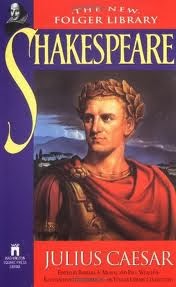 William Shakespeare
William Shakespeare
Two tribunes, Flavius and Murellus, find scores of Roman citizens wandering the streets, neglecting their work in order to watch Julius Caesar’s triumphal parade: Caesar has defeated the sons of the deceased Roman general Pompey, his archrival, in battle. The tribunes scold the citizens for abandoning their duties and remove decorations from Caesar’s statues. Caesar enters with his entourage, including the military and political figures Brutus, Cassius, and Antony. A Soothsayer calls out to Caesar to “beware the Ides of March,” but Caesar ignores him and proceeds with his victory celebration (I.ii.19, I.ii.25).Cassius and Brutus, both longtime intimates of Caesar and each other, converse. Cassius tells Brutus that he has seemed distant lately; Brutus replies that he has been at war with himself. Cassius states that he wishes Brutus could see himself as others see him, for then Brutus would realize how honored and respected he is. Brutus says that he fears that the people want Caesar to become king, which would overturn the republic. Cassius concurs that Caesar is treated like a god though he is merely a man, no better than Brutus or Cassius. Cassius recalls incidents of Caesar’s physical weakness and marvels that this fallible man has become so powerful. He blames his and Brutus’s lack of will for allowing Caesar’s rise to power: surely the rise of such a man cannot be the work of fate. Brutus considers Cassius’s words as Caesar returns. Upon seeing Cassius, Caesar tells Antony that he deeply distrusts Cassius.
Caesar departs, and another politician, Casca, tells Brutus and Cassius that, during the celebration, Antony offered the crown to Caesar three times and the people cheered, but Caesar refused it each time. He reports that Caesar then fell to the ground and had some kind of seizure before the crowd; his demonstration of weakness, however, did not alter the plebeians’ devotion to him. Brutus goes home to consider Cassius’s words regarding Caesar’s poor qualifications to rule, while Cassius hatches a plot to draw Brutus into a conspiracy against Caesar.
That night, Rome is plagued with violent weather and a variety of bad omens and portents. Brutus finds letters in his house apparently written by Roman citizens worried that Caesar has become too powerful. The letters have in fact been forged and planted by Cassius, who knows that if Brutus believes it is the people’s will, he will support a plot to remove Caesar from power. A committed supporter of the republic, Brutus fears the possibility of a dictator-led empire, worrying that the populace would lose its voice. Cassius arrives at Brutus’s home with his conspirators, and Brutus, who has already been won over by the letters, takes control of the meeting. The men agree to lure Caesar from his house and kill him. Cassius wants to kill Antony too, for Antony will surely try to hinder their plans, but Brutus disagrees, believing that too many deaths will render their plot too bloody and dishonor them. Having agreed to spare Antony, the conspirators depart. Portia, Brutus’s wife, observes that Brutus appears preoccupied. She pleads with him to confide in her, but he rebuffs her.
8:27 AM
<<<<>>>>
Tweet
<<<>>
Though Okonkwo is a respected leader in the Umuofia tribe of theIgbo people, he lives in fear of becoming his father – a man known for his laziness and cowardice. Throughout his life, Okonkwo attempts to be his father’s polar opposite. From an early age, he builds his home and reputation as a precocious wrestler and hard-working farmer. Okonkwo’s efforts pay off big time and he becomes wealthy through his crops and scores three wives.
Okonkwo’s life is shaken up a when an accidental murder takes place and Okonkwo ends up adopting a boy from another village. The boy is named Ikemefuna and Okonkwo comes to love him like a son. In fact, he loves him more than his natural son, Nwoye. After three years, though, the tribe decides that Ikemefuna must die. When the men of Umuofia take Ikemefuna into the forest to slaughter him, Okonkwo actually participates in the murder. Although he’s just killed his adoptive son, Okonkwo shows no emotion because he wants to be seen as Mr. Macho and not be weak like his own father was. Inside, though, Okonkwo feels painful guilt and regret. But since Okonkwo was so wrapped up in being tough and emotionless, he alienates himself from Nwoye, who was like a brother to Ikemefuna.
Later on, during a funeral, Okonkwo accidentally shoots and kills a boy. For his crime, the town exiles him for seven years to his mother’s homeland, Mbanta. There, he learns about the coming of the white missionaries whose arrival signals the beginning of the end for the Igbo people. They bring Christianity and win over Igbo outcasts as their first converts. As the Christian religion gains legitimacy, more and more Igbo people are converted. Just when Okonkwo has finished his seven-year sentence and is allowed to return home, his son Nwoye converts to Christianity. Okonkwo is so bent out of shape that he disowns his son.
Eventually, the Igbo attempt to talk to the missionaries, but the Christians capture the Igbo leaders and jail them for several days until the villagers cough up some ransom money. Contemplating revenge, the Igbo people hold a war council and Okonkwo is one of the biggest advocates for aggressive action. However, during the council, a court messenger from the missionaries arrives and tells the men to stop the meeting. Enraged, Okonkwo kills him. Realizing that his clan will not go to war against the white men, the proud, devastated Okonkwo hangs himself.
THINGS FALL APART
Chinua Achebe
Okonkwo’s life is shaken up a when an accidental murder takes place and Okonkwo ends up adopting a boy from another village. The boy is named Ikemefuna and Okonkwo comes to love him like a son. In fact, he loves him more than his natural son, Nwoye. After three years, though, the tribe decides that Ikemefuna must die. When the men of Umuofia take Ikemefuna into the forest to slaughter him, Okonkwo actually participates in the murder. Although he’s just killed his adoptive son, Okonkwo shows no emotion because he wants to be seen as Mr. Macho and not be weak like his own father was. Inside, though, Okonkwo feels painful guilt and regret. But since Okonkwo was so wrapped up in being tough and emotionless, he alienates himself from Nwoye, who was like a brother to Ikemefuna.
Later on, during a funeral, Okonkwo accidentally shoots and kills a boy. For his crime, the town exiles him for seven years to his mother’s homeland, Mbanta. There, he learns about the coming of the white missionaries whose arrival signals the beginning of the end for the Igbo people. They bring Christianity and win over Igbo outcasts as their first converts. As the Christian religion gains legitimacy, more and more Igbo people are converted. Just when Okonkwo has finished his seven-year sentence and is allowed to return home, his son Nwoye converts to Christianity. Okonkwo is so bent out of shape that he disowns his son.
Eventually, the Igbo attempt to talk to the missionaries, but the Christians capture the Igbo leaders and jail them for several days until the villagers cough up some ransom money. Contemplating revenge, the Igbo people hold a war council and Okonkwo is one of the biggest advocates for aggressive action. However, during the council, a court messenger from the missionaries arrives and tells the men to stop the meeting. Enraged, Okonkwo kills him. Realizing that his clan will not go to war against the white men, the proud, devastated Okonkwo hangs himself.
7:47 AM
Tweet
In the streets of Verona another brawl breaks out between the servants of the feuding noble families of Capulet and Montague. Benvolio, a Montague, tries to stop the fighting, but is himself embroiled when the rash Capulet, Tybalt, arrives on the scene. After citizens outraged by the constant violence beat back the warring factions, Prince Escalus, the ruler of Verona, attempts to prevent any further conflicts between the families by decreeing death for any individual who disturbs the peace in the future.Romeo, the son of Montague, runs into his cousin Benvolio, who had earlier seen Romeo moping in a grove of sycamores. After some prodding by Benvolio, Romeo confides that he is in love with Rosaline, a woman who does not return his affections. Benvolio counsels him to forget this woman and find another, more beautiful one, but Romeo remains despondent.
Meanwhile, Paris, a kinsman of the Prince, seeks Juliet’s hand in marriage. Her father Capulet, though happy at the match, asks Paris to wait two years, since Juliet is not yet even fourteen. Capulet dispatches a servant with a list of people to invite to a masquerade and feast he traditionally holds. He invites Paris to the feast, hoping that Paris will begin to win Juliet’s heart.
Romeo and Benvolio, still discussing Rosaline, encounter the Capulet servant bearing the list of invitations. Benvolio suggests that they attend, since that will allow Romeo to compare his beloved to other beautiful women of Verona. Romeo agrees to go with Benvolio to the feast, but only because Rosaline, whose name he reads on the list, will be there.
In Capulet’s household, young Juliet talks with her mother, Lady Capulet, and her nurse about the possibility of marrying Paris. Juliet has not yet considered marriage, but agrees to look at Paris during the feast to see if she thinks she could fall in love with him.
The feast begins. A melancholy Romeo follows Benvolio and their witty friend Mercutio to Capulet’s house. Once inside, Romeo sees Juliet from a distance and instantly falls in love with her; he forgets about Rosaline completely. As Romeo watches Juliet, entranced, a young Capulet, Tybalt, recognizes him, and is enraged that a Montague would sneak into a Capulet feast. He prepares to attack, but Capulet holds him back. Soon, Romeo speaks to Juliet, and the two experience a profound attraction. They kiss, not even knowing each other’s names. When he finds out from Juliet’s nurse that she is the daughter of Capulet—his family’s enemy—he becomes distraught. When Juliet learns that the young man she has just kissed is the son of Montague, she grows equally upset.
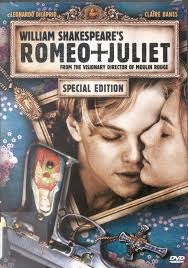 ROMEO AND JULIET
ROMEO AND JULIET
William Shakespeare
DOWNLOADIn the streets of Verona another brawl breaks out between the servants of the feuding noble families of Capulet and Montague. Benvolio, a Montague, tries to stop the fighting, but is himself embroiled when the rash Capulet, Tybalt, arrives on the scene. After citizens outraged by the constant violence beat back the warring factions, Prince Escalus, the ruler of Verona, attempts to prevent any further conflicts between the families by decreeing death for any individual who disturbs the peace in the future.Romeo, the son of Montague, runs into his cousin Benvolio, who had earlier seen Romeo moping in a grove of sycamores. After some prodding by Benvolio, Romeo confides that he is in love with Rosaline, a woman who does not return his affections. Benvolio counsels him to forget this woman and find another, more beautiful one, but Romeo remains despondent.
Meanwhile, Paris, a kinsman of the Prince, seeks Juliet’s hand in marriage. Her father Capulet, though happy at the match, asks Paris to wait two years, since Juliet is not yet even fourteen. Capulet dispatches a servant with a list of people to invite to a masquerade and feast he traditionally holds. He invites Paris to the feast, hoping that Paris will begin to win Juliet’s heart.
Romeo and Benvolio, still discussing Rosaline, encounter the Capulet servant bearing the list of invitations. Benvolio suggests that they attend, since that will allow Romeo to compare his beloved to other beautiful women of Verona. Romeo agrees to go with Benvolio to the feast, but only because Rosaline, whose name he reads on the list, will be there.
In Capulet’s household, young Juliet talks with her mother, Lady Capulet, and her nurse about the possibility of marrying Paris. Juliet has not yet considered marriage, but agrees to look at Paris during the feast to see if she thinks she could fall in love with him.
The feast begins. A melancholy Romeo follows Benvolio and their witty friend Mercutio to Capulet’s house. Once inside, Romeo sees Juliet from a distance and instantly falls in love with her; he forgets about Rosaline completely. As Romeo watches Juliet, entranced, a young Capulet, Tybalt, recognizes him, and is enraged that a Montague would sneak into a Capulet feast. He prepares to attack, but Capulet holds him back. Soon, Romeo speaks to Juliet, and the two experience a profound attraction. They kiss, not even knowing each other’s names. When he finds out from Juliet’s nurse that she is the daughter of Capulet—his family’s enemy—he becomes distraught. When Juliet learns that the young man she has just kissed is the son of Montague, she grows equally upset.
7:34 AM



